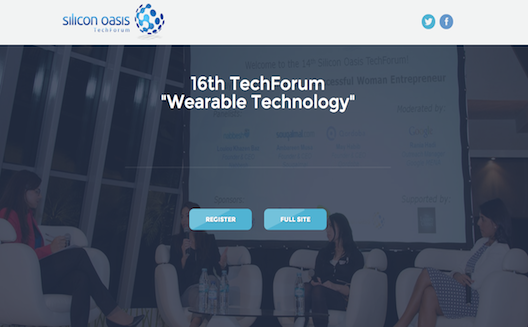TechForum Dubai: how will wearables impact our daily lives?


Organizers of the 16th TechForum, held on September 16
at Dubai Silicon
Oasis in partnership with the Emirati telecom Etisalat, wanted
the answer to only one question: “How are wearables affecting
society?”
Wearables
occupy an important place in the technology sector today, with
global sales expected to grow from $15 million USD in 2013 to $70
million USD in 2017, according to Juniper
Research, sure to be boosted by the launch of Apple’s smart watch next year.
Companies are trying to cope with the growing phenomenon, as well
as introduce the latest technologies, and find new ways to attract
users.
TechForum addressed the use of wearables as catalysts
for positive change and included a virtual tour to unveil the
benefits of such technologies on society.
Wearables saving lives
Martin Molnar, CEO of Dubai-based Tupelo, told us that the goal of
his company is to rely on research more than technology to improve
the lives of the users of wearables. “We don’t just want to offer a
modern device, but rather a device that makes your life better,” he
said.
Molnar pointed out that recent studies reveal that
obesity is reaching epidemic levels and costing governments
millions of dollars. He also pointed out heart disease as one of
the leading causes of death in the Arab world. Because most of the
studies and research funds are allocated for the United States,
Tupelo decided to base itself in Dubai so as to better target the
currently underserved Arab market.
Tupelo offers its users three wearables so
far: Mymo, MyBalance, and MyBeat, each of which has a distinct set
of features, and is linked to apps available for both iOS and
Android for access to all the fitness data.
However, Molnar believes that the interest of users
in these devices does not always last, even if the goal is good
health. He reported that 80% of users in the United States neglect
their devices, while 85% of Middle Eastern users forget all about
them after a few weeks of fascination with their new toy.
Tupelo wants to distinguish
itself from other companies by monetizing the project on one hand,
rather than accepting research grants, and ensuring sustainable
participation from users on another. Molnar believes that the best
solution is a reward system, like the
one the company uses with its Mymo, by which users collect points as
they participate in physical activity, which they can redeem for
rewards.

A virtual tour
The British Clicks and Links chose
TechForum to take the audience on a virtual tour of its latest
wearables. Vin Sumner, Clicks and Links’ managing director, said
that the event is a chance to test out Oculus, a device
acquired by
Facebook earlier this year. He believes that the
acquisition helped pave the way for more innovation in virtual
technology. The company’s newest product, Rift, a virtual reality
headset, allows developers to build apps that enable players to
‘enter’ the world of their favorite games. The device will be
available as of the second quarter of 2015 with global sales
expected to hit at least 1 million devices.
Sumner says that virtual reality has witnessed
significant development in the last 20 years, both in terms of
technology and design, especially that new interfaces and means are
now available to interact with virtual reality, such as Leap Motion,
Myo, and
Kinect 2, i.e. devices that rely on movement.
Virtual reality has changed the equation in the
gaming industry, but it also stands to play an increasingly
important role in daily life. It can be used, according to Sumner,
in medical and military training as well as in hazardous
environments, or for simulations for disaster planning, civil
planning, or even
tourism.
There is no doubt that new device innovations will
lure more people to the world of wearables. However, the potential
for the industry does not rely on technology alone, but also on
consumer demand, which will require significant time and money.

Leave a Reply